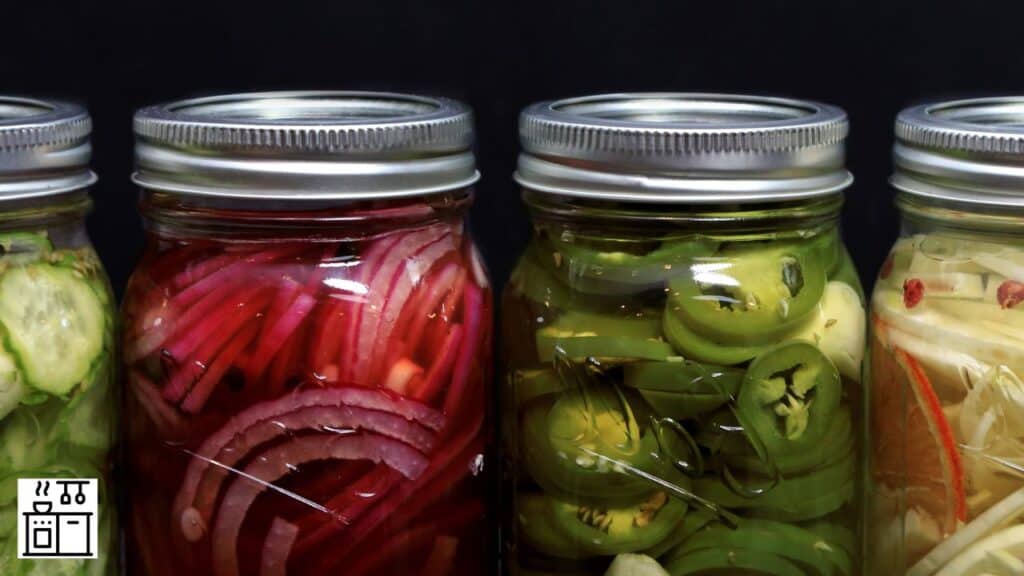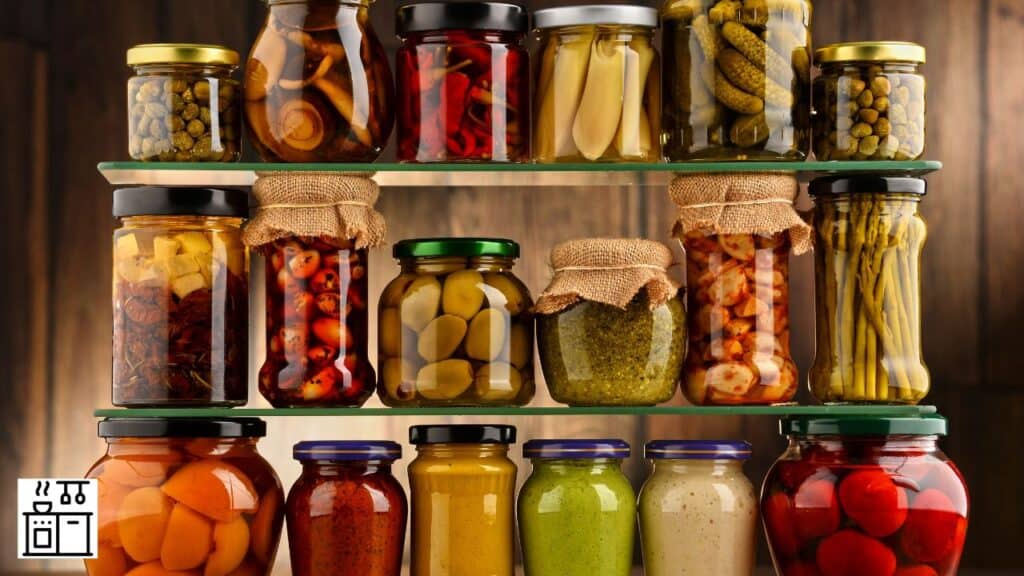Pickling is an age-old practice of preserving vegetables for a long time by placing them in a liquid medium like brine water or vinegar. Pickled vegetables taste like the original vegetable but are deliciously salty and spicy. So, what are pickles made of?
Pickles are vegetables placed in a preservation solution to prevent spoilage. Various vegetables like cucumbers, carrots, and onions can be pickled. The preservation liquid is usually a brine solution made with vinegar and salt. You can also add special seasonings and herbs to the brine for flavor.
Let’s now take a closer look at the main ingredients that go into pickles.
4 Types Of Ingredients In Pickles
Different types of ingredients are used to make different types of pickles.
The most commonly used types of ingredients include the following.
1. Fruits and vegetables.
Cucumbers are the most commonly used vegetables for pickles.
However, you can also use other vegetables like carrots, onions, leeks, broccoli, garlic, chilies, olives, beets, mangoes, lemons, and other citrus fruits.
You can also pickle fish, meat, and eggs.
2. Ingredients used for the preserving solution.
The pickled ingredients are usually placed in a salt solution made with vinegar and salt.
Some recipes use sugar, spices, and other flavoring ingredients as well.
Commercially available pickles may also contain preservatives, stabilizers, and coloring agents.
Sugar or molasses syrup is used to make sweet pickles.
3. Herbs and spices.
Herbs like dill, garlic, pepper, and ginger are used to flavor pickles.
Similarly, you may also use spices like mustard seeds, chili powder, turmeric powder, pepper, and cinnamon.
Recommended: Can Pickled Onions Go Bad? | What Can You Use Instead Of Vidalia Onions? | 2 Main Ingredients Of Dumplings
4. Ingredients in store-bought pickles.
Homemade pickles use only a few ingredients.
However, store-bought pickles contain several additional ingredients, including preserving agents, stabilizers, and colors.
Commercial manufacturers use mechanized processes and large-scale machines for the pickling process.
So the steps are different from those used to make homemade pickles.
Additionally, the ingredient list will also be different.
Pickle manufacturers use colors like turmeric caramel or chlorophyll to make the pickles attractive.
Sulfur dioxide may also be added to slow down the color change of the ingredients.
Alum and lime are some of the other ingredients that are added to give the pickle more bite.
Store-bought pickles may or may not be fermented.
Direct pasteurization is often used to eliminate any germs present in the pickle and extend its shelf-life.
Fresh-pack pickles contain vegetables marinated in a brine solution and sealed in bottles.
4 Different Methods Of Pickling
We can broadly classify pickling methods into four main types.
1. Quick Pickling Method
Quick pickling is a good way to preserve vegetables like cucumbers, carrots, cauliflowers, and peppers for a short time.
In this method, the preservation solution is made by mixing vinegar and water.
You may also add spices to the liquid.
The vegetables are kept whole or chopped into bite-size pieces.
They’re placed inside the canning jars, and the preservation liquid is poured over them.
2. Salt-Brine Method
The salt brining method is suitable for vegetables with high liquid content, like cucumbers and zucchini.
Placing these vegetables in a salt solution will draw out the excess moisture from their cells.
It intensifies their flavors.
In this method, the pickling ingredients are rubbed with salt and set aside for several hours till the excess moisture is released.
They’re then transferred into canning jars.
Finally, the salted vegetables are submerged in a vinegar-based preservation liquid.
Flavoring agents like herbs and spices are added to this liquid.
3. Vinegar-Brining Method
The vinegar-brining method follows the same sequence of steps as the salt-brine method.
However, the difference is that the brining process is performed several times to draw out the water gradually.
So the vegetables are soaked and drained repetitively till all the moisture comes out.
When the pickling liquid is finally added, the cells are saturated with it.
This method is used for sweet gherkins, soft fruits, and vegetable and fruit rinds.
4. Fermentation Method
The fermentation pickling method is the most time-consuming method of pickling.
The curing process involves naturally-occurring bacteria and takes a long time.
The process also significantly alters the texture and taste of the ingredients because the bacteria produce chemical changes in the food.
Here, the pickling liquid is a saltwater brine solution.
The salt in the liquid draws out the moisture from the pickling ingredients.
Naturally present microbes in the solution convert the sugars in the ingredients into lactic acid, which preserves the vegetables.
Due to the formation of lactic acid, there is no further need to add vinegar, sugar, or other preserving agents.
Pickles produced by the fermentation technique have a distinct flavor and texture.
This method is used to make kimchi, sauerkraut, and other exotic pickles.
3 Benefits Of Pickling Vegetables

Pickling has various benefits. Let’s find out what they are.
For ages, pickling has been practiced all over the world.
This technique was practiced long before refrigeration and canning processes became popular.
It was perhaps invented out of necessity to preserve nature’s bounty for times of scarcity.
Pickles would not only keep for a long time but could also be taken anywhere.
Pickling continues to be very popular even today because there are many ways in which you can use pickled produce.
They are a versatile ingredient that you can eat raw or add to sandwiches, salads, and various other dishes.
So, it isn’t surprising that supermarkets and grocery stores always have pickles in stock.
The main benefits of pickling vegetables are as follows.
1. Preserves excess produce for later use.
Fresh produce has a short shelf-life.
When stored at room temperature, most vegetables spoil in a few days.
They may hold up for longer in the refrigerator.
Nevertheless, they will usually not last beyond a week.
Pickling drastically extends the shelf-life of vegetables and fruits.
The preserving liquid seals the ingredients from bacteria and other environmental agents that cause food spoilage.
Hence, pickling will make the vegetables last for months at a stretch.
2. Is simple to make.
The simplicity of the technique makes pickling easy and almost effortless.
In the most basic form, pickles contain just vegetables in a preserving solution.
The entire process doesn’t involve much effort or specialized equipment.
You will only need a handful of ingredients, mixing spoons, and glass jars for pickling.
3. Has a wide range of uses.
Pickles are delicious on their own. You can eat them raw, as a snack.
In addition to this, you can also add them to various dishes.
Pickles are often added to sandwiches and burgers.
They add delicious flavors and make these snacks or meals tastier.
Pickles can also be chopped and added to salads and dips to enhance their flavor.
Sweet pickles, where the vegetables are soaked in a sugar-based preservative solution, can even be enjoyed as a dessert.
Related: How Much Salt Do Dishwashers Need? | Can Strainers And Sifters Be Used Interchangeably? | What Do Corn Dogs Contain?
How Long Do Pickles Last?
The main purpose of pickling is food preservation. It’s a reliable technique to make fresh ingredients last longer.
Pickles usually keep for several weeks or months, depending on the pickling technique employed.
Brine or vinegar solution is used for pickling.
It protects the ingredients from heat, moisture, and bacteria that cause food spoilage.
Hence, the pickle remains undisturbed and doesn’t spoil for a long time.
Nevertheless, pickles eventually go bad. Properly sealed pickles can last for 1 to 2 years when stored properly.
They will spoil faster once opened.
Once opened, you should always store pickles in the refrigerator and use them before the expiry date.
Store-bought pickles will have a use-by date on the bottle.
Although they may be safe for consumption beyond this date, the manufacturer doesn’t guarantee the quality beyond this time.
The presence of any brown, black, or white coloration on the surface indicates spoilage. It’s best to toss such pickles.
Some people remove the ugly bits and continue to use the pickle.
However, it’s risky as any remaining spoiled bits can be harmful.

